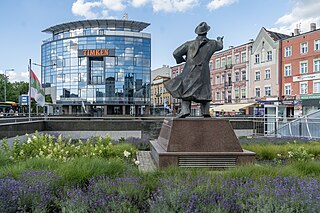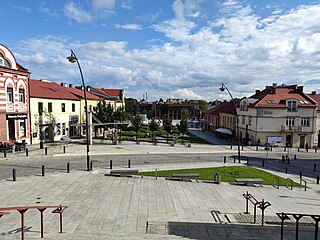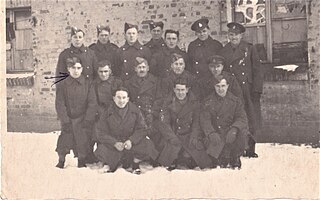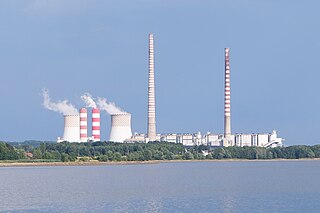
Zabrze is an industrial city in Silesia in southern Poland, near Katowice. It lies in the western part of the Metropolis GZM, a metropolis with a population of around 2 million. It is in the Silesian Highlands, on the Bytomka River, a tributary of the Oder.

Sosnowiec is an industrial city county in the Dąbrowa Basin of southern Poland, in the Silesian Voivodeship, which is also part of the Metropolis GZM municipal association. Located in the eastern part of the Upper Silesian Industrial Region, Sosnowiec is one of the cities of the Katowice urban area, which is a conurbation with a total population of 2.7 million people; as well as the greater Katowice-Ostrava metropolitan area populated by about 5.3 million people. The population of the city is 189,178 as of December 2022.

Bytom is a city in Upper Silesia, in southern Poland. Located in the Silesian Voivodeship, the city is 7 km northwest of Katowice, the regional capital.

Chorzów is a city in the Silesia region of southern Poland, near Katowice. Chorzów is one of the central cities of the Metropolis GZM – a metropolis with a population of 2 million. It is located in the Silesian Highlands, on the Rawa River.

Trzebinia is a town in Chrzanów County, Lesser Poland, Poland with an Orlen oil refinery and a major rail junction of the Kraków - Katowice line, with connections to Oświęcim and Spytkowice. The town became part of Lesser Poland Voivodeship after being part of Katowice Voivodeship (1975–1998). With population of 20,175, Trzebinia is an important industrial center. The town lies in the Kraków-Częstochowa Upland, 269 to 407 m above sea level. Trzebinia is a rail and road hub, and lies at a junction of the A4 Motorway and National Road Nr. 79. The distance to John Paul II International Airport Kraków-Balice is 30 kilometres.

Jaworzno is a city in southern Poland, near Katowice. It lies in the Silesian Highlands, on the Przemsza river. Jaworzno belongs to Lesser Poland and despite belonging to Silesian Voivodeship since 1999, Jaworzno is not part of Silesia. The city is situated in the Silesian Voivodeship since its formation in 1999, previously (1975–1999) it was in Katowice Voivodeship. Jaworzno is one of the cities of the 2,7 million conurbation – Katowice urban area and within a greater Katowice-Ostrava metropolitan area populated by about 5,294,000 people. The population of the city is 89,350 (2021).

Baborów is a town in Gmina Baborów, Głubczyce County, Opole Voivodeship, southern Poland. The town has an area of 11.86 square kilometres, and as of June 2022 it has a population of 2,852. Baborów lies on the river Psina.

Stalag VIII-B was most recently a German Army administered POW camp during World War II, later renumbered Stalag-344, located near the village of Lamsdorf in Silesia. The camp contained barracks built to house British and French World War I POWs. The site had housed POWs of the Franco-Prussian War of 1870-71.

Rybnik Power Station is a hard coal-fired power station at Rybnik in Poland. The power station was built in the 1970s. It has installed power generation capacity of 1,775 MW. The average annual production of electricity amounts to 9 TWh. Rybnik Power Station has two 120-metre (390 ft) tall cooling towers and two large flue gas stacks, one with a height of 260 metres (850 ft) and another with a height of 300 metres (980 ft).

Bobrek is a district of the city of Bytom in the Silesian Voivodeship, Poland. The district borders Szombierki to its east, Karb to its north, Ruda Śląska to its south and Zabrze to its west. As of 2011 it has a population of roughly 5 thousand people.

The Krupiński coal mine is a large mine in the south of Poland in Suszec, Silesian Voivodeship, 448 km south-west of the capital, Warsaw. Krupiński represents one of the largest coal reserve in Poland having estimated reserves of 34.8 million tonnes of coal. The annual coal production is around 3 million tonnes. The mine is based in Suszec, the deposits of which are located in the commune of Suszec, Żory and Orzesze in the Silesian Voivodeship. Employment at the end of 2011 amounted to 2819 employees. March 31, 2017 production in the mine was shut down and the plant was transferred to the Spółka Restrukturyzacji Kopalń in Bytom. This company is liquidating and managing the assets of liquidated mines.

Szombierki Power Station is a coal-fired power station in Szombierki district of Bytom, Poland. Operational since 1920, since the 1990s it operates at a limited capacity, and is regarded as a monument due to its architectural values. Its first owner was Schaffgotsch Bergwerksgesellschaft GmbH. Its over all height is 120 meters.

Szombierki Coal Mine is a former coal mine in Szombierki, Bytom, Poland. It was created in 1870 from several smaller coal fields. From mid-1990s it began to be closed down.

The Church of the Sacred Heart of Jesus is a historical Roman Catholic building in Bydgoszcz, Poland. It stands at 5 Piastowski Square in the city's downtown district Śródmieście. The church is registered on the Kuyavian-Pomeranian Voivodeship Heritage List.

The Church of the Savior is a neo-Gothic Lutheran church in Bydgoszcz. Located on Savior Square along Warszawska Street, it was called Christ Church till 1945.

Kolonia Zgorzelec is a workers' settlement in Bytom, Poland.

Beuthen District, or Beuthen Rural District was an Upper Silesian rural district with its seat in Beuthen, which itself was a separate district - an urban district.

Osiedle Młodego Górnika is a residential area located in north-eastern Zabrze. It was established in 2003.

The spoil tip in Tarnowskie Góry, Poland, was formed from the accumulation of dolomite waste during the peak of lead, silver, and zinc ore extraction at the Royal Friedrich Mine in Bobrowniki.

The Witczak Winding Tower is a peripheral winding tower of the liquidated Centrum Coal Mine in Bytom, Poland. The winding tower stands at 35 meters tall, and is located in the Rozbark district of the city—some 3km from the main structure of the former Centrum Coal Mine.
































